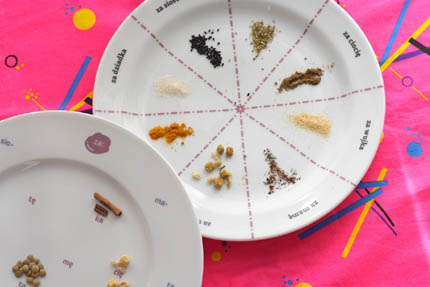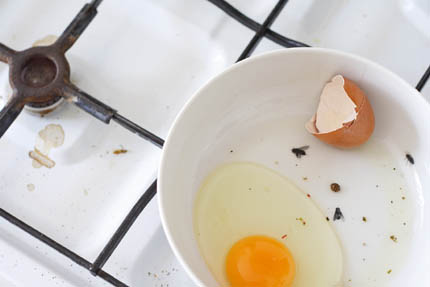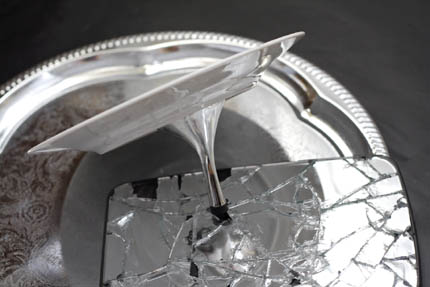
Vernissage: Freitag, 27. Mai 2011, 20 Uhr
Karina Marusińska
Between
Curator: Agnieszka Kurgan
in Cooperation with BWA Galleries Wrocław
Opening hours: Monday - Saturday 12.00 - 18.00
Exhibition lasts till: 8.06.2011
|
Who is Karina Marusińska? A designer, anti-designer, potter, installation artist, performer? Contemporary definitions of design – treating it as a critical operation on human imagination located legitimately among other visual arts – make such questions and distinctions pointless. And this understanding of design is characteristic of Marusińska’s creative activity, who represents the youngest generation of Polish designers.
Her first individual exhibition “Between” shows how diverse her works are. It includes utilitarian designs, some of which were made in short series in porcelain factories, and others remained prototypes waiting for production. But that is not everything. The exhibition also displays works that look like manufacturing rejects or flawed products at first sight, an association which is perfectly justified. When working in the factories, Marusińska explores piles of scrapped by-products in search of their reusability, new functions and aesthetic value. This is how REproducts, Chipped, Handles, Uhaha, Well hung and Weathered were made. Another group of works is a commentary to the production processes in factories, their repeatability and alienation of accepted patterns. In Hard made and Q, the signatures which serve as an internal language of communication among the workers become ornaments, replacing the classic floral motifs. Relations, Steamers, Semi-products or Dripped make use of industrial semi-products in new functions – objects merged in technological processing. Those twisted mutants pay homage to the uniqueness of a flaw. Manipulation and playing with form and meaning are in turn the leading motifs of the projects Security tag, Pickled, Cores, CaleidosCUP, Pla(y)te, VaseLID and SURprise. Marusińska invites the user to engage in a game by breaking away with the conventional approach and looking for new associations. Some of her works go even further, provoking and causing disgust, sneering at the notion of “good taste” and “table etiquette”. Squat is a plate inspired in its form by squatting toilets and so it looks like one (the project may bring to mind the scene from Luis Bunuel’s “Phantom of Liberty”, where the guests sit at the table on toilet seats and it is the eating that is done secretly and in hiding, like an obscene activity). Hairy is a cup-and-saucer set decorated with hairs embedded in the bottom. They affect our prejudices and the disgusting vision of finding a hair in our tea (as well as referring to another surrealist icon – Meret Oppenheim’s furry breakfast). Yet another set of works deals with the sociological and feminist issues in which the artist is especially interested. Taboo is a series of photographs by Justyna Fedes, in which the female members of the Łuhuu! artistic group, stylized to resemble baroque porcelain figurines, are caught in intimate, embarrassing poses – picking the nose, squeezing the zits or adjusting underwear. Traditionally, the porcelain figurines of this type are displayed in special showcases in representative places and they depict properly courteous generic scenes. Here, Marusińska plays with the convention. Ultimately, she plans to make actual porcelain figurines caught in those intimate situations, basing them on the photographs. All different, all diverse is a paraphrased slogan of equality parades, calling for tolerance (originally “All different, all equal”). This series of photographs shows mass-produced Chinese porcelain figurines that should theoretically be identical, but in fact they differ, especially in facial expressions and anatomical detail. Emblema is a project that originated during the 46th international plein-air in Bolesławiec and it documents Marusińska’s work in the porcelain factory. The characteristic element featuring in all the photos are the designer’s blue fingernails, a reference to the traditionally pale-blue Bolesławiec glaze. How to reconcile the craving for being a beautiful, well-kept woman with the physical work in the factory, requiring direct contact with clay? And then there is the Dog with the nodding head. This icon of the 1980’s, the head-swaying toy that used to be placed in so many Polish cars, appears in a refreshed, minimalistic, porcelain version which will not decorate car interiors but rather modern flats – a sentimental, surrealist flashback of the Communist kitsch. “Between” is an interdisciplinary project that presents Karina Marusińska’s creative output in a wide range of aspects. It is also an attempt to show how many problems modern design may touch, how thin the line between design and anti-design is nowadays. The exhibition proves that the departure from an attempted classification and labels attached to modern art is also valid in industrial design, and that porcelain is far more than the boring, classical tableware to be found in every house. Agnieszka Kurgan |
|
||||||||
|
|||||||||
|
Karina Marusinska (1983) graduate from Academy of Fine Arts in Wroclaw (Ceramics Design). Studies under scholarship programs at Pais Vasco University in Bilbao, Spain (2007) and at the Institute of Ceramics in Guebwiller, France (2008). Manifold scholar, laureate of nationwide and international prizes; participation in numerous exhibitions, symposia, plein-airs and festivals either at home country or abroad.
Animator of culture, organizer of art festivals, workshops and plein-airs. A member of an art Luhuu! www.luhuu.pl and also project group Wzorowo www.wzorowo.com. She works either in design or artistic creation and often blur the bound between them. In her artworks she plays with recipient’s senses and his appreciation. She also establishs to Polish tradition. She looks for solutions based on connecting different fields of art, science and ecology and explores the phenomenon of recycling in every little way. She is interested in creative management of industrial waste. more on www.marusinska.pl With kind support of Adam Mickiewicz Institute  |
|
| home |



